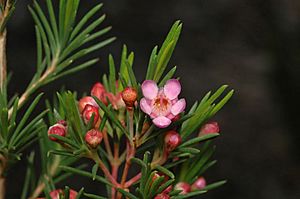Scruffy verticordia facts for kids
Quick facts for kids Scruffy verticordia |
|
|---|---|
 |
|
| Conservation status | |
| Scientific classification | |
| Genus: |
Verticordia
|
| Species: |
apecta
|
The scruffy verticordia, also called the Hay River featherflower, is a special kind of flowering plant. Its scientific name is Verticordia apecta. It belongs to the myrtle family, called Myrtaceae. This plant only grows in the south-west part of Western Australia. This means it is endemic to that area.
The scruffy verticordia is a thin shrub. Its leaves change shape depending on where they are on the plant. The leaves near the bottom are long and thin. Higher up, the leaves are more oval-shaped. The leaves closest to the flowers are egg-shaped. It has only a few flowers. These flowers grow on long stems near the top leaves. The outer parts of the flowers, called sepals, are deep pink. They have delicate white fringes, like tiny hairs.
Contents
What Does the Scruffy Verticordia Look Like?
The Verticordia apecta is a thin, upright shrub. It usually has one main stem. This plant grows to be about 20 to 45 centimeters (8 to 18 inches) tall. Its leaves look different depending on where they are on the plant.
The leaves lower down on the stem are long and narrow. They are shaped like a triangle if you cut them across. These lower leaves are about 3 to 9 millimeters (0.1 to 0.4 inches) long. Leaves higher up on the stems are more oval-shaped. They are about 7 millimeters (0.3 inches) long. The leaves near the flowers are either oval or egg-shaped. The narrower part of these leaves points towards the stem. They are also triangular when cut across.
The plant has only a few flowers. They grow from the upper parts of the stems where leaves join. Each flower grows on a stalk that is about 9 to 19 millimeters (0.4 to 0.7 inches) long. The sepals, which are like small leaves protecting the flower, are deep pink. They are about 4 millimeters (0.2 inches) long. They have fine, white fringes on their edges.
The petals of the flower are mostly round. They are also deep pink and about 4 millimeters (0.2 inches) long. Each petal has four to six main pointed parts. It also has many smaller, tiny parts. The part of the flower that collects pollen, called the style, is very short. It is only about 0.3 millimeters (0.01 inches) long. It has short hairs near its tip. This plant usually blooms from November to January.
How the Scruffy Verticordia Got Its Name
Scientists Elizabeth George and Alex George first officially described Verticordia apecta in 1994. They found specimens, or samples, of the plant near a place called Mount Barker. Their description was published in a science journal called Nuytsia.
The second part of the plant's scientific name, apecta, comes from an Ancient Greek word. This word is ἄπεκτος (ápektos). It means "uncombed." This name was chosen because the flowers of this plant can look a bit messy or "untidy."
Elizabeth George placed this plant into a specific group of Verticordia plants. This group is called subgenus Verticordia, section Catocalypta. Other plants in this group include V. roei, V. inclusa, V. insignis, V. habrantha, V. lehmannii, and V. pritzelii.
Where the Scruffy Verticordia Lives
This type of verticordia plant grows in sandy clay soil. It is found in open woodlands where Eucalyptus wandoo trees grow. It lives in a small area near Mount Barker. This area is part of the Jarrah Forest biogeographic region.
Protecting the Scruffy Verticordia
The Verticordia apecta is a very rare plant. The Western Australian Government's Department of Parks and Wildlife calls it "Threatened Flora." This means it is a rare plant that needs protection. They have even made a plan to help it recover.
The Australian Government also lists it as "Critically Endangered" (CR). This is under the Environment Protection and Biodiversity Conservation Act 1999. In 2009, scientists thought there were only about 16 adult plants left. This plant faces two main dangers. One is fires happening too often. The other is a disease caused by a fungus called Phytophthora cinnamomi. This fungus can cause plants to die.
Growing Scruffy Verticordia
Scientists only recently discovered this plant. Because of this, not many people have tried to grow it. So far, all attempts to grow new plants from seeds or cuttings have not worked. More research is needed to help this special plant survive.


